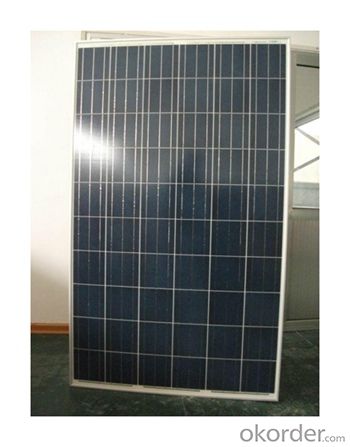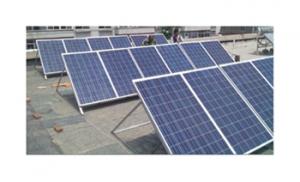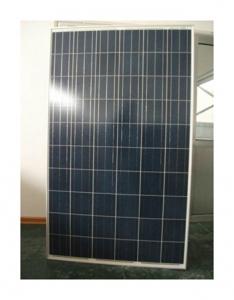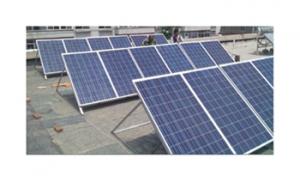Solar Modulels Poly-crystalline 230W 156*156 Module
OKorder Service Pledge
OKorder Financial Service
You Might Also Like
Solar Module Descriptions:
Solar Power Modules (known as Photovoltaics - PV) can generate electricity for your home or business, either as part of a stand-alone solar power system, or for buildings already connected to the local electricity network.
PV systems use the most abundant energy source on the planet, solar radiation, to generate electricity. They are silent, consume no fuel and generate no pollution. They also contribute to the reduction of greenhouse gas emissions; a 2kW PV system on a house will prevent the emission of about 40 tonnes of CO2 during its projected 30 year lifetime. Furthermore, the use of PV will reduce your electricity bills and exposure to fluctuating and steadily rising electricity prices.


Electrical Characteristics
Max-power (W) | 230 |
Max-Power Voltage (V) | 29.50 |
Max-Power Current (A) | 7.80 |
Open-Circuit Voltage (V) | 36.80 |
Short-Circuit Current (A) | 8.28 |
Mechanical Characteristics
Cable type, Diameter and Length | 4mm2, TUV certified, 1000mm |
Type of Connector | Compatible with MC4 plug |
Arrangement of cells | 6*10 |
Cell Size | 156*156 |
Dimension | 1580*1069*45 |
Weight | 19.5Kg |
Glass, Type and Thickness | High Transmission, Low Iron, Tempered Glass 3.2mm |
Features
Guaranteed positive tolerance 0/+5w ensures power output reliability
Strong aluminum frames module can bear snow loads up to 5400Pa and wind loads up to 2400Pa.
Excellent performance under low light environments (mornings evenings and cloudy days)
12 years for product defects in materials and workmanship and 25 years for 80% of warranted minimum power.
Certifications and standards: IEC 61215.
Manufactured according to International Quality and Environment Management System (ISO9001, ISO14100).
FAQ
Q: What kind of loads can I run on PV?
With a correctly designed PV system you can power almost any electrical load. However, as the load size increases the expense also increases. Loads like hot water heaters, air conditioners, room heaters and electric stoves should be avoided. The added cost of trying to power loads like these is very cost prohibitive. If these loads have to be powered it will be a lot less expensive to change the appliance to use an alternative fuel type like propane.
Q: What is PV & how does it work?
PV stands for photovoltaic. Photo = Light and Voltaic = Electricity. A solar cell converts light to electricity.
A solar cell is made of silicon. Computer chips are made of this same material. Basically, when light strikes the surface of a solar cell some of it is absorbed into the silicon. This light energy bumps the electrons loose and causes energy to flow.
By packaging approximately 36 solar cells together a solar panel or a solar module is created. When you have more then one solar panels you create a solar array.
- Q:How do you prevent overheating of a solar controller?
- To prevent overheating of a solar controller, it is important to ensure proper ventilation and airflow around the controller. This can be achieved by placing the controller in a well-ventilated area with sufficient space around it. Additionally, avoiding direct sunlight exposure and installing the controller in a shaded location can also help prevent overheating.
- Q:How does a solar controller prevent overcharging of batteries?
- A solar controller prevents overcharging of batteries by regulating the flow of solar energy from the solar panels to the batteries. It constantly monitors the battery voltage and adjusts the charging current accordingly to ensure that the batteries are charged efficiently without being overcharged.
- Q:Can a solar controller be used with a solar-powered public transportation facility?
- Yes, a solar controller can be used with a solar-powered public transportation facility. A solar controller is a crucial component in regulating and optimizing the charging and discharging of batteries in a solar power system. It ensures that the solar panels are efficiently converting sunlight into electricity and that the batteries are being charged and discharged at the appropriate levels. In a solar-powered public transportation facility, a solar controller would help manage the energy flow from the solar panels to power the electric buses or trains, ensuring reliable and sustainable operation.
- Q:Can a solar controller be used with solar panels that are connected to a solar water pump?
- Yes, a solar controller can be used with solar panels that are connected to a solar water pump. The purpose of a solar controller is to regulate the flow of electricity from the solar panels to the connected device, in this case, the solar water pump. It ensures that the solar panels operate at their maximum efficiency and protects the pump from overcharging or damage.
- Q:Can a solar controller be used with a mobile solar setup?
- Yes, a solar controller can be used with a mobile solar setup. A solar controller is designed to regulate the charging and discharging of batteries in a solar power system, ensuring the batteries are charged efficiently and preventing overcharging or damage. Whether it is a fixed or mobile solar setup, a solar controller helps optimize the performance and lifespan of the batteries.
- Q:How does a solar controller handle shading on solar panels?
- A solar controller handles shading on solar panels by implementing a technique called Maximum Power Point Tracking (MPPT). This technology allows the controller to constantly monitor the output voltage and current of the solar panels and adjust them accordingly to maximize power production. When shading occurs on a solar panel, the MPPT algorithm will automatically detect the shaded area and dynamically reconfigure the panel's operating point to bypass the shaded cells and optimize power generation from the unshaded cells. This ensures that the solar panel system continues to operate efficiently and generate maximum power output, even in partially shaded conditions.
- Q:What is the role of a solar controller in preventing battery over-voltage?
- The role of a solar controller in preventing battery over-voltage is to regulate the flow of energy from the solar panels to the battery, ensuring that the battery does not receive an excessive charge. The solar controller monitors the voltage level of the battery and automatically disconnects the solar panels when the battery reaches its maximum safe voltage. By preventing over-voltage, the solar controller helps protect the battery from damage and extends its lifespan.
- Q:Can a solar controller be used in a solar-powered electric fence system?
- Yes, a solar controller can be used in a solar-powered electric fence system. A solar controller helps regulate the charging and discharging of the batteries in the system, ensuring efficient and effective operation of the electric fence.
- Q:How do I prevent deep discharge of batteries with a solar controller?
- To avoid the occurrence of deep battery discharge with a solar controller, there are several crucial measures you can take: 1. Opt for a suitable solar controller: Ensure that the solar controller you choose is equipped with a deep discharge protection feature. This feature will actively monitor the battery voltage and prevent it from falling below a specific threshold, thus safeguarding it against excessive discharge. 2. Establish the low voltage disconnect (LVD) level: Most solar controllers permit the adjustment of the LVD level, which determines the point at which the controller will disconnect the load to prevent further battery discharge. Set the LVD level to a secure value that guarantees the battery will not be discharged below the recommended minimum voltage. 3. Regularly monitor the battery voltage: Keep a close watch on the battery voltage by employing a battery monitor or voltage meter. This will enable you to assess the battery's state of charge and ensure it does not decline excessively. If you observe the voltage approaching the LVD level, take appropriate action to recharge the battery. 4. Implement battery protection measures: If you possess a substantial solar system or anticipate being away for an extended period, consider incorporating supplementary battery protection measures. These measures may involve the utilization of devices such as a battery protector or a low voltage disconnect switch, which will automatically isolate the battery from the system once it reaches a specific voltage threshold. 5. Adequately size your solar system: Verify that your solar panel array is appropriately sized in relation to your battery bank. A properly sized system will generate sufficient power to keep your batteries adequately charged and prevent deep discharge. It is imperative to take into account factors such as daily energy consumption, weather conditions, and battery capacity when sizing your solar system. By adhering to these steps and consistently monitoring your battery voltage, you can effectively avert deep battery discharge with the assistance of a solar controller. This will contribute to prolonging the lifespan of your batteries and ensuring optimal performance of your solar system.
- Q:How does a solar controller handle battery under-temperature protection?
- A solar controller handles battery under-temperature protection by monitoring the temperature of the battery and adjusting the charging parameters accordingly. If the battery temperature drops below a certain threshold, the controller reduces the charging current to prevent damage to the battery. This helps to maintain the battery's performance and prolong its lifespan.
1. Manufacturer Overview |
|
|---|---|
| Location | |
| Year Established | |
| Annual Output Value | |
| Main Markets | |
| Company Certifications | |
2. Manufacturer Certificates |
|
|---|---|
| a) Certification Name | |
| Range | |
| Reference | |
| Validity Period | |
3. Manufacturer Capability |
|
|---|---|
| a)Trade Capacity | |
| Nearest Port | |
| Export Percentage | |
| No.of Employees in Trade Department | |
| Language Spoken: | |
| b)Factory Information | |
| Factory Size: | |
| No. of Production Lines | |
| Contract Manufacturing | |
| Product Price Range | |
Send your message to us
Solar Modulels Poly-crystalline 230W 156*156 Module
OKorder Service Pledge
OKorder Financial Service
Similar products
New products
Hot products
Related keywords





























